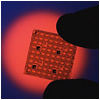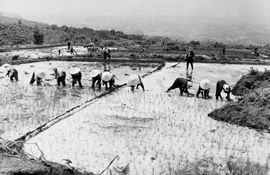
|

農業
- 戦後日本の農地改革
- 日本の農地改革が成功した理由
- 水稲農業
- 田植え
- 初期の機械化農業
- 農地の再編成
- 野菜果物栽培の革新
- 米の配給と補助金制度
- 日本の農業人口の減少
- 農家の規模と後継者問題
- 日本の農業の担い手
- 三ちゃん農業
- 日本人の食生活の変化
- 日本の酪農
- 日本人はどのような乳製品を食べるのでしょうか
- 日本の肉牛
- 農家の収入の変化
- 日本の養蚕
- 日本における食糧の自給
- 日本における米の自給
- 日本における有機農業
|

Villagers working together to transplant rice seedlings. 1956.
Photo from Mainichi Shimbun.
Transplanting Rice Seedlings
Rice seed is first planted close together in one flooded paddy and grows into seedlings that will be transplanted into many paddy fields. Until the 1960s, farmers transplanted rice by hand when the seedlings were about 8-10 inches tall. The schedule for flooding the paddy fields required the fields to be transplanted in a certain order, because the paddy had to be flooded and the soil worked into a soft mud to accept the rice seedlings.
Villagers worked together to do the transplanting efficiently. A large group of villagers gathered in a long row across one flooded paddy, standing in the water and each carrying a handful of rice seedlings. Everyone planted one seedling in the row, and then stepped back one step and planted the next row. They could quickly plant one paddy field in neat, even rows, and then move on to the next paddy field. Transplanting was hard, backbreaking work, but it was also an occasion for singing and enjoying each other’s company as they worked together.
Click on Pictures to see a close-up of transplanted rice seedlings.
|
言葉の説明:
rice paddy
|
transplant (rice)
|
| ポッドキャスト ダウンロード:
英語
| 日本語
|
|
文書 |
ビデオクリップ |
図表 |
写真 |
地図
|
|

